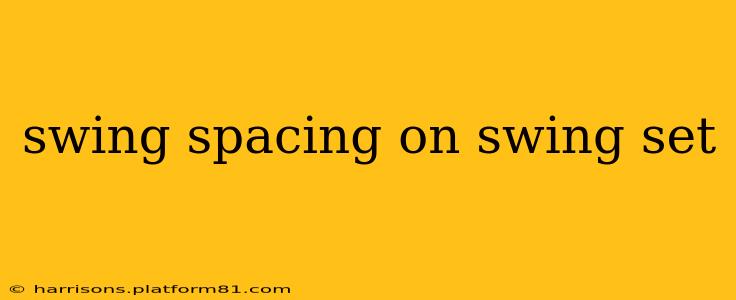Choosing the right swing spacing on your swing set is crucial for both safety and enjoyment. Improper spacing can lead to collisions, injuries, and frustrated children. This guide will delve into the ideal spacing, considerations for different swing types, and frequently asked questions to help you create the perfect swinging experience.
What is the recommended spacing between swings?
The generally recommended spacing between swings is 18 to 24 inches. This distance provides ample room for children to swing freely without the risk of colliding with each other or the swing set frame. However, this is a minimum recommendation. More space is always better, especially if you have younger children or those who swing with a wide arc.
How much space do I need between swings and the supports?
Beyond swing-to-swing spacing, you need adequate clearance between the swings and the supporting structure of the swing set. A minimum of 12 inches is recommended to prevent accidental impacts. Again, more space is preferable to ensure safety. Consider the widest point of the swing's arc when calculating this space.
What about different types of swings?
The spacing recommendations can slightly vary depending on the type of swing:
- Standard Bucket Swings: These require the standard 18-24 inches spacing, with careful consideration given to the potential wide swing arc.
- Belt Swings: Belt swings tend to have a smaller swing arc than bucket swings, potentially allowing for slightly closer spacing; however, adhering to the minimum 18-inch recommendation remains safest.
- Nested Swings: Nested swings, designed for multiple children on one swing, require the most space, often necessitating adjustments to the overall design of the swing set to avoid crowding.
How do I determine the right swing spacing for my children's ages and sizes?
While the standard spacing is a good guideline, consider your children's ages and sizes. If you have younger children or those who swing with a particularly wide arc, increasing the spacing is strongly advised. Observe their swinging patterns to gauge the necessary space. If they regularly come close to the supports or each other, it's time to adjust the spacing.
What happens if swings are too close together?
Swings that are too close together greatly increase the risk of collisions. This can lead to:
- Injuries: Collisions can result in bumps, bruises, and more serious injuries, particularly to the head and face.
- Frustration: Children may become frustrated and unwilling to swing if they constantly fear colliding with others.
- Reduced enjoyment: Close proximity diminishes the fun and freedom of swinging.
Can I add more swings to my existing swing set?
Adding swings to an existing swing set requires careful assessment of the current spacing and the overall structural integrity of the swing set. Consult the manufacturer's instructions or a qualified professional before modifying your swing set. Ensure that there is enough space to safely accommodate additional swings without compromising safety or the structural integrity of the set.
What are some tips for ensuring swing safety beyond spacing?
Beyond spacing, other critical safety measures include:
- Regular inspections: Check for loose bolts, damaged wood, and other potential hazards regularly.
- Appropriate supervision: Always supervise children while they are swinging.
- Proper installation: Ensure the swing set is correctly installed according to the manufacturer's instructions.
- Safe surfacing: Use appropriate shock-absorbing surfacing beneath the swings, such as wood chips, sand, or poured-in-place rubber.
By following these guidelines and prioritizing safety, you can create a fun and safe swinging environment for your children to enjoy for years to come. Remember that prioritizing safety is paramount when setting up any playground equipment. If you have any concerns about swing spacing or other safety aspects of your swing set, consult a qualified professional.
